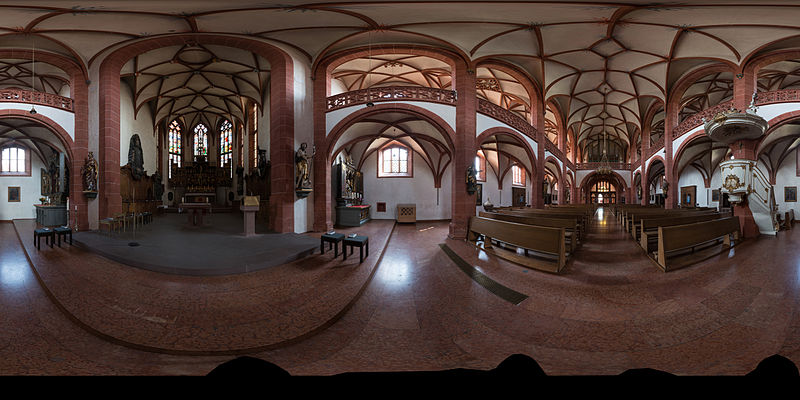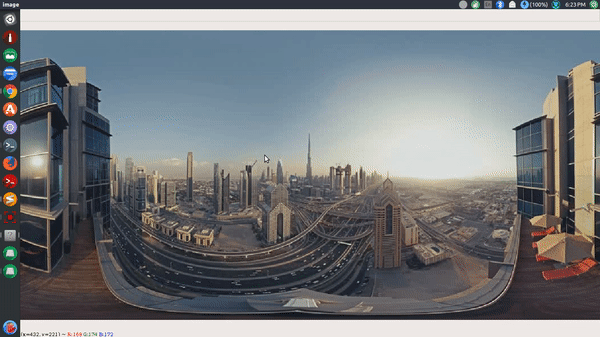Converting equirectangular image to fisheye image¶
What is an equirectangular image?
Converting equirectangular image to fisheye image It is a method of representing the curved spherical 3D world on a 2D plane in the form of longitudes and latitudes. An equirectangular image is always in a 2:1 ratio. Equirectangular images are relatively easy to visualize and are also in the form of a rectangular image. It is not only used to create 2D world maps but also to represent imagery from a full sphere rather than just a small window onto the world.[1]

An example of an equirectangular image¶
Converting an equirectangular image to fisheye image¶
For converting an equirectangular image to a fisheye image, the equirectangular image is considered to be projected on a unit sphere using the equivalent longitude and latitude coordinates of the equirectangular image and then this information is later projected on an imaging plane based on a camera model. There are several camera models proposed in the literature. OmniCV library provides implementations for several types of camera models which include the Unified Camera Model (UCM) [5], Extended Unified Camera Model (EUCM) [6], Field Of View (FOV) Camera model [7] and Double Sphere Camera Model [3].
The code for Unified Camera Model is inspired from, DeepCalib[2] and its github repository. The repository provides python which can be further modified and used for desired purpose.
Python Example¶
-
fisheyeImgConv.equirect2Fisheye_UCM(img,outShape,f=50,xi=1.2,angles=[0,0,0])¶ Function to convert equirectangular image to fisheye image using the unified camera model (UCM).
- Parameters
img – Input equirectangular image
outShape – list of [Image_Height,Image_Width] in pixels
f – Focal lenght
xi – Distortion coefficient
angles – List of camera [roll,pitch,yaw]
- Return type
Numpy array
-
fisheyeImgConv.equirect2Fisheye_EUCM(img,outShape,f=50,a_=0.5,b_=0.5,angles=[0,0,0])¶ Function to convert equirectangular image to fisheye image using the extended unified camera model (EUCM).
- Parameters
img – Input equirectangular image
outShape – list of [Image_Height,Image_Width] in pixels
f – Focal lenght
a – Distortion coefficient
b – Distortion coefficient
angles – List of camera [roll,pitch,yaw]
- Return type
Numpy array
-
fisheyeImgConv.equirect2Fisheye_FOV(img,outShape,f=50,w_=0.5,angles=[0,0,0])¶ Function to convert equirectangular image to fisheye image using the Field of View (FOV) camera model.
- Parameters
img – Input equirectangular image
outShape – list of [Image_Height,Image_Width] in pixels
f – Focal lenght
w – Distortion coefficient
angles – List of camera [roll,pitch,yaw]
- Return type
Numpy array
-
fisheyeImgConv.equirect2Fisheye_DS(img,outShape,f=50,a_=0.5,xi_=0.5,angles=[0,0,0])¶ Function to convert equirectangular image to fisheye image using the Double Sphere (DS) camera model.
- Parameters
img – Input equirectangular image
outShape – list of [Image_Height,Image_Width] in pixels
f – Focal lenght
a – Distortion coefficient
xi – Distortion coefficient
angles – List of camera [roll,pitch,yaw]
- Return type
Numpy array
Example code
#!/usr/bin/env/python
import cv2
import numpy as np
import math
import time
import sys
from omnicv import fisheyeImgConv
# Import equirectangular image
equiRect = cv2.imread(IMAGE_PATH)
# Defining output shape
outShape = [250,250]
# Creating mapper object
mapper = fisheyeImgConv()
# Converting equirectangular to fisheye using Unified Camera model (UCM)
fisheye = mapper.equirect2Fisheye_UCM(equiRect,outShape=outShape,xi=0.5)
cv2.imshow("UCM Model Output",fisheye)
cv2.waitKey(0)
# Converting equirectangular to fisheye using Extended UCM model
fisheye = mapper.equirect2Fisheye_EUCM(equiRect,outShape=[250,250],f=100,a_=0.4,b_=2,angles=[0,0,0])
cv2.imshow("EUCM Model Output",fisheye)
cv2.waitKey(0)
# Converting equirectangular to fisheye using Field Of Vide (FOV) model
fisheye = mapper.equirect2Fisheye_FOV(equiRect,outShape=[250,250],f=40,w_=0.5,angles=[0,0,0])
cv2.imshow("FOV model Output",fisheye)
cv2.waitKey(0)
# Converting equirectangular to fisheye using Double Sphere (DS) model
fisheye = mapper.equirect2Fisheye_DS(equiRect,outShape=[250,250],f=90,a_=0.4,xi_=0.8,angles=[0,0,0])
cv2.imshow("DS Model Output",fisheye)
cv2.waitKey(0)
# Changing the distortion coefficient for (UCM)
fisheye = mapper.equirect2Fisheye(equiRect,outShape=outShape,xi=0.2)
cv2.imshow("fisheye",fisheye)
cv2.waitKey(0)
# Rotate the sphere
fisheye = mapper.equirect2Fisheye(equiRect,outShape=outShape,angles=[90,0,0])
cv2.imshow("fisheye",fisheye)
cv2.waitKey(0)
C++ Example¶
-
fisheyeImgConv::equirect2Fisheye_UCM(const cv::Mat &img, cv::Mat &dstFrame, cv::Size outShape, -
float f=50, float xi=1.2,float alpha=0, float beta=0, float gamma=0); Function to convert equirectangular image to fisheye image using the unified camera model (UCM).
- Parameters
img – Input equirectangular image.
outShape – list of [Image_Height,Image_Width] in pixels.
f – Focal lenght.
xi – Distortion coefficient.
alpha – Rotation of camera about X axis.
beta – Rotation of camera about Y axis.
gamma – Rotation of camera about Z axis.
dstFrame – Output image.
-
fisheyeImgConv::equirect2Fisheye_EUCM(const cv::Mat &img, cv::Mat &dstFrame, cv::Size outShape, float f=50, -
float a_ = 0.5, float b_=0.5, float alpha=0, float beta=0, float gamma=0); Function to convert equirectangular image to fisheye image using the extended unified camera model (EUCM).
- Parameters
img – Input equirectangular image.
outShape – list of [Image_Height,Image_Width] in pixels.
f – Focal lenght.
a – Distortion coefficient.
b – Distortion coefficient.
alpha – Rotation of camera about X axis.
beta – Rotation of camera about Y axis.
gamma – Rotation of camera about Z axis.
dstFrame – Output image.
-
fisheyeImgConv::equirect2Fisheye_FOV(const cv::Mat &img, cv::Mat &dstFrame, cv::Size outShape, float f=50, -
float w_=0.5, float alpha=0, float beta=0, float gamma=0); Function to convert equirectangular image to fisheye image using the Field of View (FOV) camera model.
- Parameters
img – Input equirectangular image.
outShape – list of [Image_Height,Image_Width] in pixels.
f – Focal lenght.
w – Distortion coefficient.
alpha – Rotation of camera about X axis.
beta – Rotation of camera about Y axis.
gamma – Rotation of camera about Z axis.
dstFrame – Output image.
-
fisheyeImgConv::equirect2Fisheye_DS(const cv::Mat &img, cv::Mat &dstFrame, cv::Size outShape, float f=50, -
float a_ = 0.5, float xi_=0.5, float alpha=0, float beta=0, float gamma=0); Function to convert equirectangular image to fisheye image using the Double Sphere (DS) camera model.
- Parameters
img – Input equirectangular image.
outShape – list of [Image_Height,Image_Width] in pixels.
f – Focal lenght.
a – Distortion coefficient.
xi – Distortion coefficient.
alpha – Rotation of camera about X axis.
beta – Rotation of camera about Y axis.
gamma – Rotation of camera about Z axis.
dstFrame – Output image.
Example code
#include<iostream>
#include<opencv2/opencv.hpp>
#include"../omnicv/utils.hpp"
#include <opencv2/core/core.hpp>
// Creating the display window
int H = 500;
int W = 500;
std::string WINDOW_NAME{"viewer"};
int main()
{
cv::namedWindow(WINDOW_NAME,CV_WINDOW_NORMAL);
// cv::resizeWindow(WINDOW_NAME, 400, 400);
cv::Mat frame;
cv::Mat outFrame;
// ##### 1. Example for equirectangular to fisheye image conversion using Unified camera model ##########
frame = cv::imread("../data/equirect_temp1.jpg");
cv::imshow(WINDOW_NAME,frame);
cv::waitKey(0);
fisheyeImgConv mapper1;
mapper1.equirect2Fisheye_UCM(frame,outFrame, cv::Size (250,250),100,0.9);
cv::imshow("Unified Camera Model model output",outFrame);
cv::waitKey(0);
// ##### 2. Example for equirectangular to fisheye image conversion using Extended Unified camera model ##########
frame = cv::imread("../data/equirect_temp1.jpg");
cv::imshow(WINDOW_NAME,frame);
cv::waitKey(0);
fisheyeImgConv mapper1;
mapper1.equirect2Fisheye_EUCM(frame,outFrame, cv::Size (250,250),100,0.4,2);
cv::imshow("Extended Unified Camera Model model output",outFrame);
cv::waitKey(0);
// ##### 3. Example for equirectangular to fisheye image conversion using Field of View camera model ##########
frame = cv::imread("../data/equirect_temp1.jpg");
cv::imshow(WINDOW_NAME,frame);
cv::waitKey(0);
fisheyeImgConv mapper1;
mapper1.equirect2Fisheye_FOV(frame,outFrame, cv::Size (250,250),50,1.2);
cv::imshow("Field of View model output",outFrame);
cv::waitKey(0);
// ##### 4. Example for equirectangular to fisheye image conversion using Double Sphere camera model ##########
frame = cv::imread("../data/equirect_temp1.jpg");
cv::imshow(WINDOW_NAME,frame);
cv::waitKey(0);
fisheyeImgConv mapper1;
mapper1.equirect2Fisheye_DS(frame,outFrame, cv::Size (250,250),50,0.4,0.8);
cv::imshow("Double Sphere model output",outFrame);
cv::waitKey(0);
return 0;
}
Results¶

Converting equirectangular image to fisheye image using UCM model¶
refer to the example code. to know the other ways of using this conversion
Reference¶
[1] Google AR VR blog - https://blog.google/products/google-vr/bringing-pixels-front-and-center-vr-video/
[2] Bogdan, Oleksandr & Eckstein, Viktor & Rameau, François & Bazin, Jean-Charles. (2018). DeepCalib: a deep learning approach for automatic intrinsic calibration of wide field-of-view cameras. 1-10. 10.1145/3278471.3278479.
[3] Usenko, Vladyslav & Demmel, Nikolaus & Cremers, Daniel. (2018). The Double Sphere Camera Model.
[4] Kannala, Juho & Brandt, Sami. (2006). A Generic Camera Model and Calibration Method for Conventional, Wide-Angle, and Fish-Eye Lenses. IEEE transactions on pattern analysis and machine intelligence. 28. 1335-40. 10.1109/TPAMI.2006.153.
[5] C. Geyer and K. Daniilidis. A unifying theory for central panoramic systems and practical implications. In D.Vernon, editor, Computer Vision — ECCV 2000, pages 445–461, Berlin, Heidelberg, 2000. Springer Berlin Heidelberg.
[6] B. Khomutenko, G. Garcia, and P. Martinet. An enhanced unified camera model. IEEE Robotics and Automation Letters, 1(1):137–144, Jan 2016.
[7] F. Devernay and O. Faugeras. Straight lines have to be straight. Machine vision and applications, 13(1):14–24, 2001.